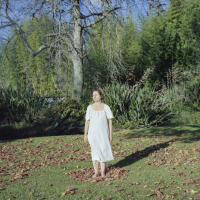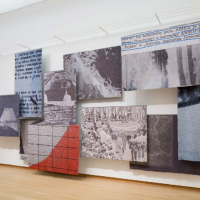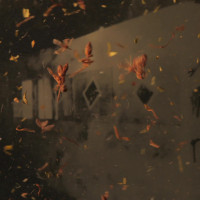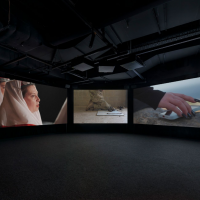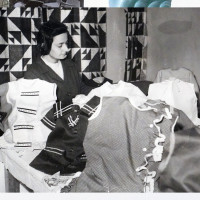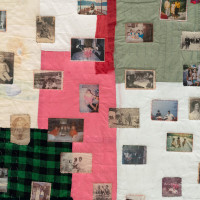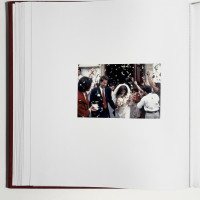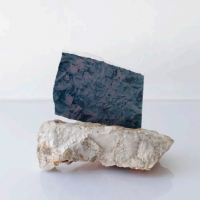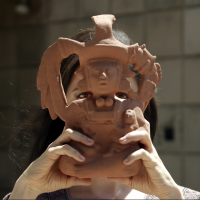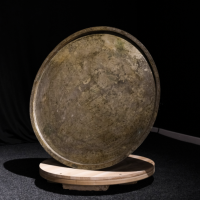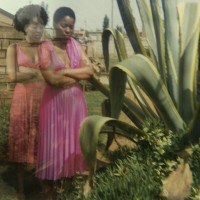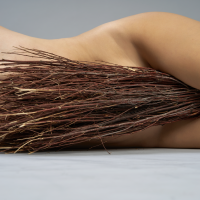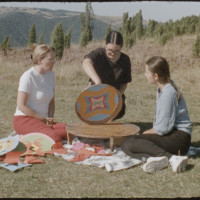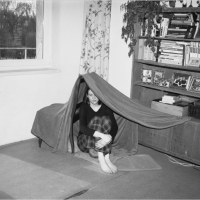The exhibition takes its inspiration from tepsijanje, a traditional musical practice rooted in Kosovo, performed largely by women. This unique form combines vocal melodies with the rhythmic spinning of a copper pan (tepsija). Here, tepsijanje becomes a metaphor for inherited gestures—passed from mother to daughter—that bridge generations with those of the past. Centred on an unnamed female singer, the exhibition explores gendered traditions and their ongoing subversion, examining photography, moving images, and sonic practices as powerful mediums and archives of intergenerational narratives.
The exhibition pays homage to filmmaker Trinh T. Minh-ha who, in Woman, Native, Other, described the diseuse —the storyteller, thought-woman, griotte, and fortune-teller—as someone whose truths unfold in time. “If you have the patience to listen, she will take delight in relating it to you.”[1] The works in She who starts the song… embody these archetypes, inviting audiences to engage with the ancestral stories shared by grandmothers.
The opening section of the exhibition presents works by Huda Takriti, Kristina Benjocki, Joanna Piotrowska, Lebohang Kganye, and Angela Blažanović, each grappling with fragmented memories and the (im)possibility of retracing familial lineages. Like the spinning of a tepsija, their slow, deliberate gestures revive ancestral tales at risk of being lost.
The wind then rises. The howl and hum heighten. As Ivana Bašić's lung-like glass sculptures speak to the breath that formed them, Saodat Ismailova’s amulets, like talismans, whisper a song that journeys beyond time. Clarissa Tossin’s installation resurrects pre-Columbian Mayan wind instruments through 3D-printed replicas of those held in museum collections, reinvigorating Indigenous knowledge systems by allowing sound to, once again, resound. Lala Raščić, whose work inspired the exhibition’s title, alongside Semâ Bekirović and Astrit Ismaili, contend with the tepsija as an object, seeking ways to “spin out” of constraining traditions and oppressive social structures.
As the exhibition draws to a close, it shifts its focus to archetypes of rebellion and liberation. From the relentless labour of factory workers in Željka Gita Blakšić’s work to the indelible scars of war in Stanislava Pinchuk’s installation, these pieces interrogate the enduring f figures of the hag and the griotte—unmarried, childless, independent women often vilified for their agency. Here, the storytalker transforms into conjurers and spider women, reclaiming power in movements that both undermine and liberate.
“I wanted to write about silences and terror and acts that hover over generations, over centuries. I began by writing about my mother and my grandmother.”[2]
Participating artists: Ivana Basić, Kristina Benjocki, Semâ Bekirović, Angela Blažanović, Željka Gita Blakšić, Vera Hadzhiyska, Majlinda Hoxha, Astrit Ismaili, Saodat Ismailova, Šejla Kamerić, Lebohang Kganye, Ana Likar, Glorija Lizde, Maria Mavropoulou, Klodiana Millona & Endi Tupja, Joanna Piotrowska, Stanislava Pinchuk, Iva Radivojević, Lala Raščić, Simon Shiroka, Huda Takriti, and Clarissa Tossin.
[1] Trinh T. Minh-ha, ‘Grandma’s Story’ in Woman, Native, Other: Writing Postcoloniality and Feminism, 1989, Indiana University Press, pp.119–139.
[2] Christina Sharpe, Ordinary Notes, 2023, Daunt Books, pp. 26.
With the support of the Ministry of Culture of the Republic of Kosova and Raiffeisen Bank.

